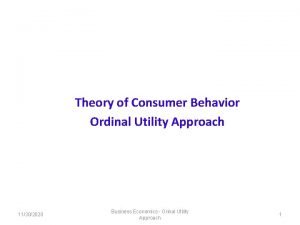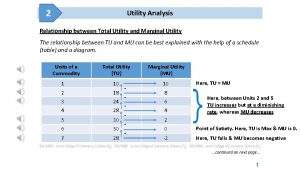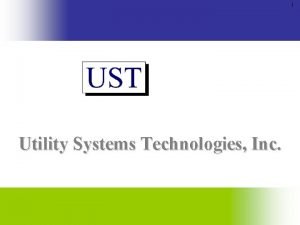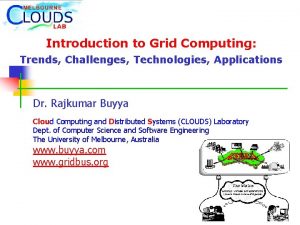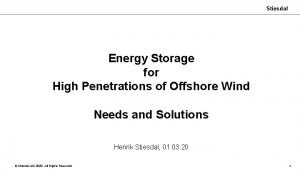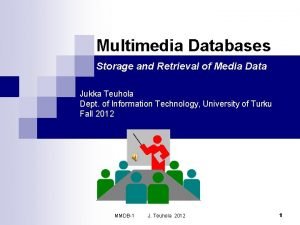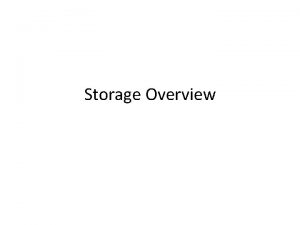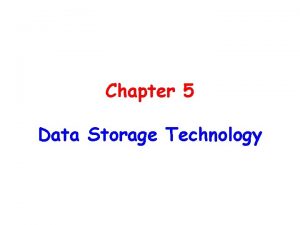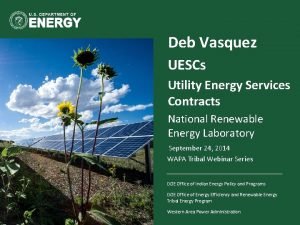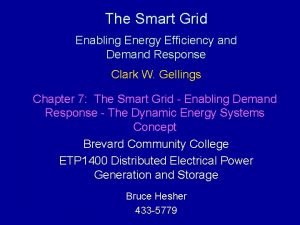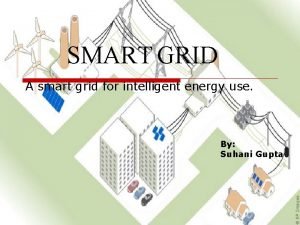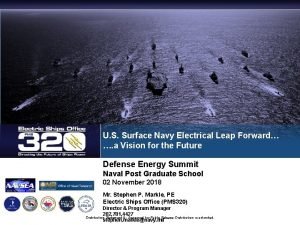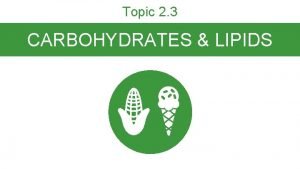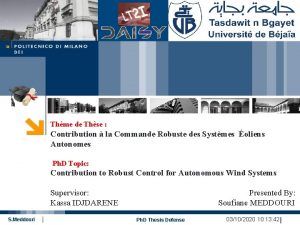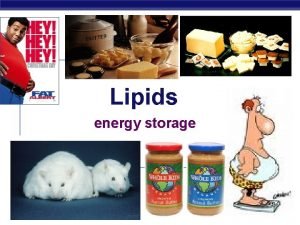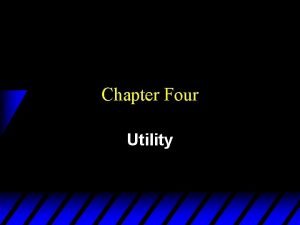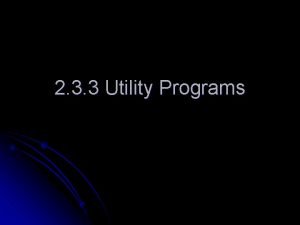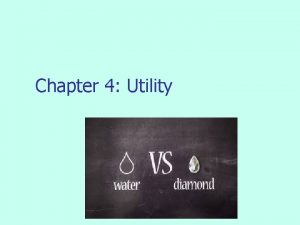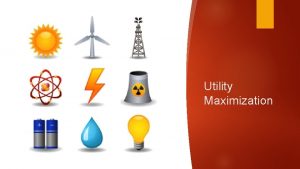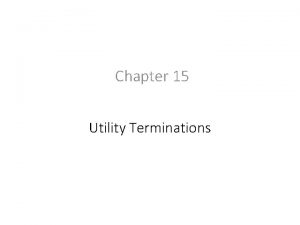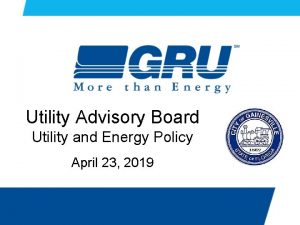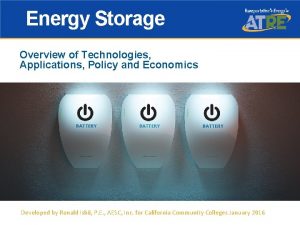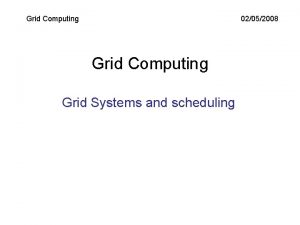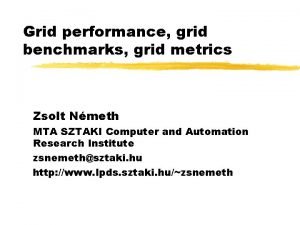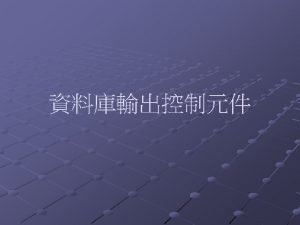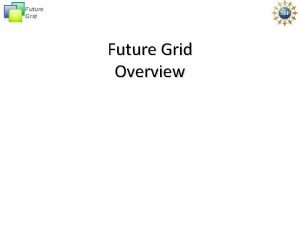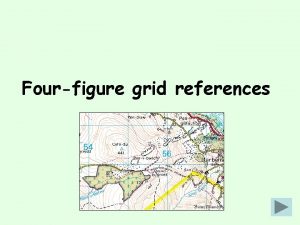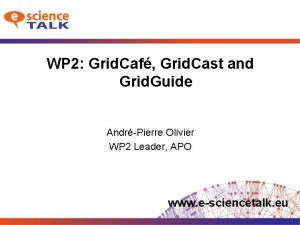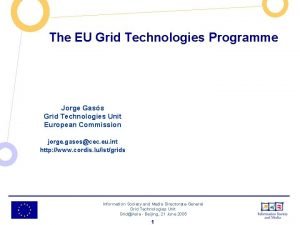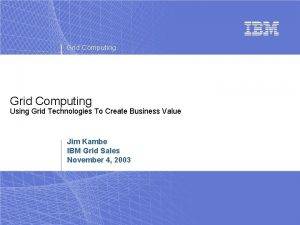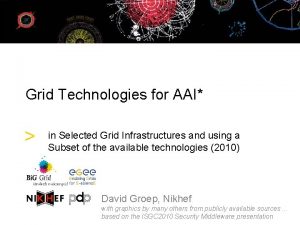Energy Storage Technologies Energy Storage Applications Utility Grid


























- Slides: 26

Energy Storage Technologies

Energy Storage Applications • Utility Grid • Customer Site • Transmission – Energy Cost Management • Bulk Storage for Load/Resource – Renewable Energy Management Output & Load Matching • Spinning Resource – Backup • Ancillary Services – Power Quality • Renewable Energy Integration • Distribution • Peaker/Backup Resource • Power Quality

Discharge Rate vs Size End-User Applications Source: EPRI

Customer Load Management * Mock load, electric rate & cost

Customer Load Management, cont. Charge 39% Cost Savings Charge Discharge *Mock load, electric rate & cost

Customer Load Management, cont. Over Generation Under Generation Charge Discharge

Energy Storage for Backup Power • Uninterruptible Power Supply (UPS) – Critical device level • Facility Backup – Critical systems or buildings APC Back-UPS, 200 Watts /350 VA, Input 120 V /Output 120 V ABB Conceptpower DPA 500 100 k. W up to 3 MW

Power Quality • Impulsive Transient • Oscillatory Transient • Sag/Swell • Under-/Over-voltage • Interruption • Harmonic Distortion • Voltage Flicker • Electrostatic Discharge • Noise Power Quality is Important The symptoms of a power quality problem could be as subtle as a light that dims every time a large motor starts or as catastrophic as equipment failure. Whatever the case, power quality problems may disrupt your business operations. Today, there is widespread use of digital or microprocessor controlled devices in all areas of our customer's businesses. Many of these new devices are more sensitive and may not operate properly when small variations or disruptions in the electrical supply occurs. Some examples of problems that occur due to power quality problems are: Automatic Resets, Data Errors, Equipment Failure, Circuit Board Failure, Memory Loss, Power Supply Problems, UPS Alarms, Software Corruption, and Overheating of electrical distribution systems. Source: https: //www. hawaiianelectric. com/for-businesses/power-quality-forbusinesses/power-quality-problems

Microgrids and Storage Potential benefits are the same, but scaled for local services • • Allows microgrids to operate non-carbon emitting resources Helps achieve islanding and shifting time-of-use Allows distributed generation to synchronize with or without the presence of the grid (PV generation requires a voltage source with which to synchronize) “Smooths” power flow from intermittent sources Image source: Siemens, Inc.

Simple Electric Energy Storage Device Electric to Stored Energy Conversion AC to ? Conversion Losses Stored to Electric Energy Reconversion ? to AC Conversion Losses y L os se s nd b St a e rg ha sc Di Energy Storage Capacity ge ar Ch AC Electricity Stored Energy AC Electricity

Energy Storage Technology Types • Hydraulic • Pumped Hydro Storage (PHS) • Pneumatic • Compressed Air Energy Storage (CAES) • Kinetic • Flywheel Energy Storage (FES) • Electromagnetic • Superconducting magnetic energy storage (SMES) • Electrical • Double Layer Capacitors (DLC)

Electro-Chemical Energy Storage Technology Types • Electro-chemical • Nickel Cadmium (Ni-Cd) • Iron Chromium (Fe-Cr) • Lithium Ion (Li-ion) • Sodium Sulfur (Na. S) • Lead Acid (LA) • Zinc Air (Zn-air) • Sodium Nickel Chloride (Na. Ni. Cl) • Vanadium Redox Flow Battery (VRFB) • Zinc-Bromide Hybrid Flow Battery (Zn. Br HFB)

Lithium Ion Battery

Lithium Ion Battery, cont. AES Storage LLC’s Laurel Mountain Energy Storage supplies 32 MW of regulation in PJM territory using Li-ion batteries. Source: DOE/EPRI 2013 Electricity Storage Handbook

Lithium Ion Battery, cont. A 30 k. W/34 k. Wh Distributed Energy Storage Unit being installed at the Anatolia Solar. Smart Homes in SMUD territory. Source: DOE/EPRI 2013 Electricity Storage Handbook

Lithium Ion Battery, cont. Residential Energy Storage and Energy Management System Source: DOE/EPRI 2013 Electricity Storage Handbook

Vanadium Redox Flow Battery Principles of the Vanadium Redox Battery Source: DOE/EPRI 2013 Electricity Storage Handbook

Vanadium Redox Flow Battery, cont. Prudent Energy 600 k. W/3, 600 -k. Wh VRBESS Installed at Gills Onions, Oxnard, CA Source: DOE/EPRI 2013 Electricity Storage Handbook

Zinc Bromine Flow Battery The Zinc-bromine battery is another type of flow battery in which the zinc is solid when charged and dissolved when discharged Zinc-bromine Cell Configuration Source: DOE/EPRI 2013 Electricity Storage Handbook

Zinc Bromine Flow Battery, cont. A 90 -k. W/180 -k. Wh Zincbromine Energy Storage System by Red. Flow Housed in a 20 foot shipping container. Source DOE/EPRI 2013 Electricity Storage Handbook

Iron Chromium Flow Battery Principles of Operation of an Iron-Chromium Battery Energy Storage System. Source: DOE/EPRI 2013 Energy Storage Handbook.

Iron Chromium Flow Battery Photo Courtesy of Ener. Vault. Source: DOE/EPRI 2013 Electricity Storage Handbook

Performance Source: IEC Electric Energy Storage White Paper

Grid Integrated Water Heaters • Control box that can be incorporated into a water heater to add grid interoperability. • Also adding a remotely controlled resistive heating element to the bottom of the water tank. • Since the water in the tank will naturally stratify, the utility or aggregator will have control of the initially cold water at the bottom of the tank. • The remotely controlled resistive element is used to preheat this cold “make-up” water as needed to any temperature up to standard DHW temperatures. Thus, consistent DHW temperatures are maintained at the outlet.

“Cool” Thermal Energy Storage • A heat sink can be generated during off peak periods to provide cooling during on-peak periods. • Chilled water, ice “shuckers”, ice on coil, eutectic salt systems available. • Economic benefits dependent on electric rate design (TOU, peak demand charges, etc. ) and when building cooling load can occur. • Can be used for industrial process and agricultural cooling too. Source: U. S. Dept. of Energy

Hydrogen Energy Storage Anode Reaction: 2 H 2 O → O 2 + 4 H+ + 4 e. Cathode Reaction: 4 H+ + 4 e- → 2 H 2 Source: U. S. DOE Office of Energy Efficiency & Renewable Energy • Hydrogen is “clean” non-GHG producing fuel for fuel cells and combustion engines. It can be used for electric generation, mechanical power, heating, cooling and transportation purposes. • Electrolysis of water is one way to produce hydrogen and can use electricity produced from renewable resources. • Electrolyzers can range in size from small, appliance-size equipment to large-scale, central production facilities. • The round trip efficiency today is as low as 30 to 40% but could increase up to 50% if more efficient technologies are developed. [Source: Energy Storage Association]
 Ordinal utility
Ordinal utility Relation between marginal utility and total utility
Relation between marginal utility and total utility Utility systems technologies
Utility systems technologies Internet technologies and applications
Internet technologies and applications Emerging database technologies
Emerging database technologies Emerging database technologies and applications
Emerging database technologies and applications Lga pga
Lga pga Conclusion of grid computing
Conclusion of grid computing Stiesdal storage technologies a/s
Stiesdal storage technologies a/s Storage and retrieval technologies in multimedia
Storage and retrieval technologies in multimedia Types of network storage
Types of network storage The primary storage technologies are:
The primary storage technologies are: Utility energy service contracts
Utility energy service contracts Primary storage and secondary storage
Primary storage and secondary storage Storage devices of computer
Storage devices of computer Secondary storage provides temporary or volatile storage
Secondary storage provides temporary or volatile storage Unified storage vs traditional storage
Unified storage vs traditional storage Smart grid enables distributed energy management
Smart grid enables distributed energy management A smart grid for intelligent energy use
A smart grid for intelligent energy use Energy energy transfer and general energy analysis
Energy energy transfer and general energy analysis Energy energy transfer and general energy analysis
Energy energy transfer and general energy analysis Pms 320 navy
Pms 320 navy Are lipids energy storage
Are lipids energy storage 2.thme
2.thme Are lipids energy storage
Are lipids energy storage Examples of lipids
Examples of lipids Classes of lipids
Classes of lipids
